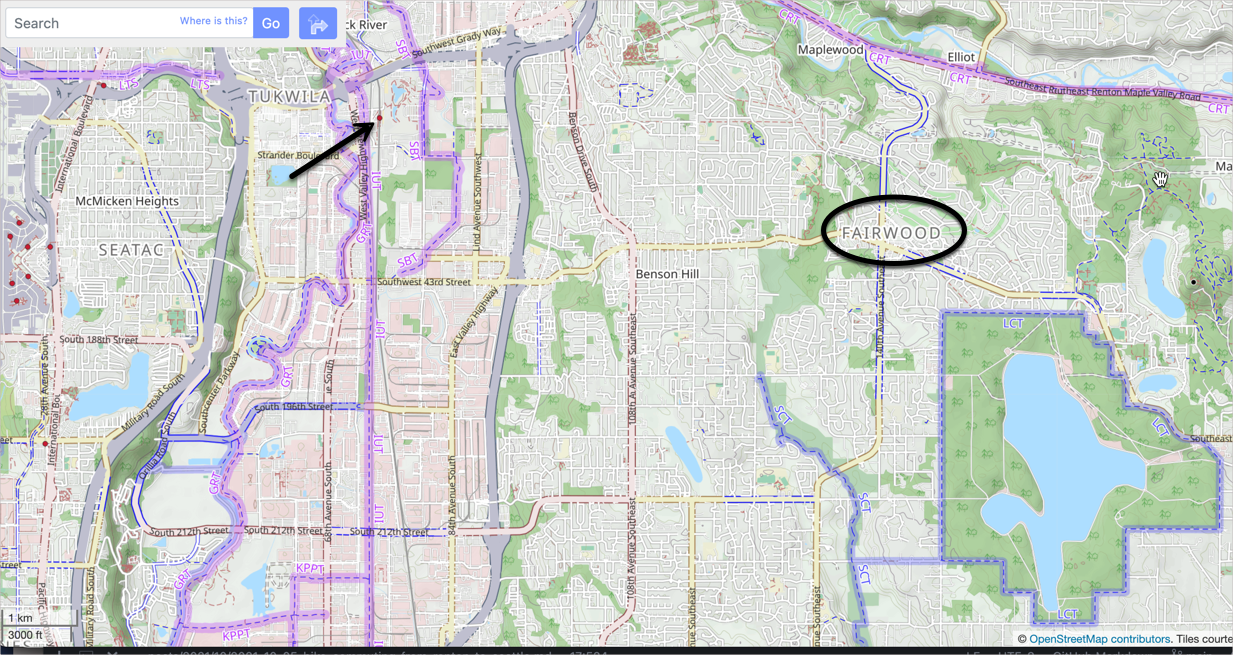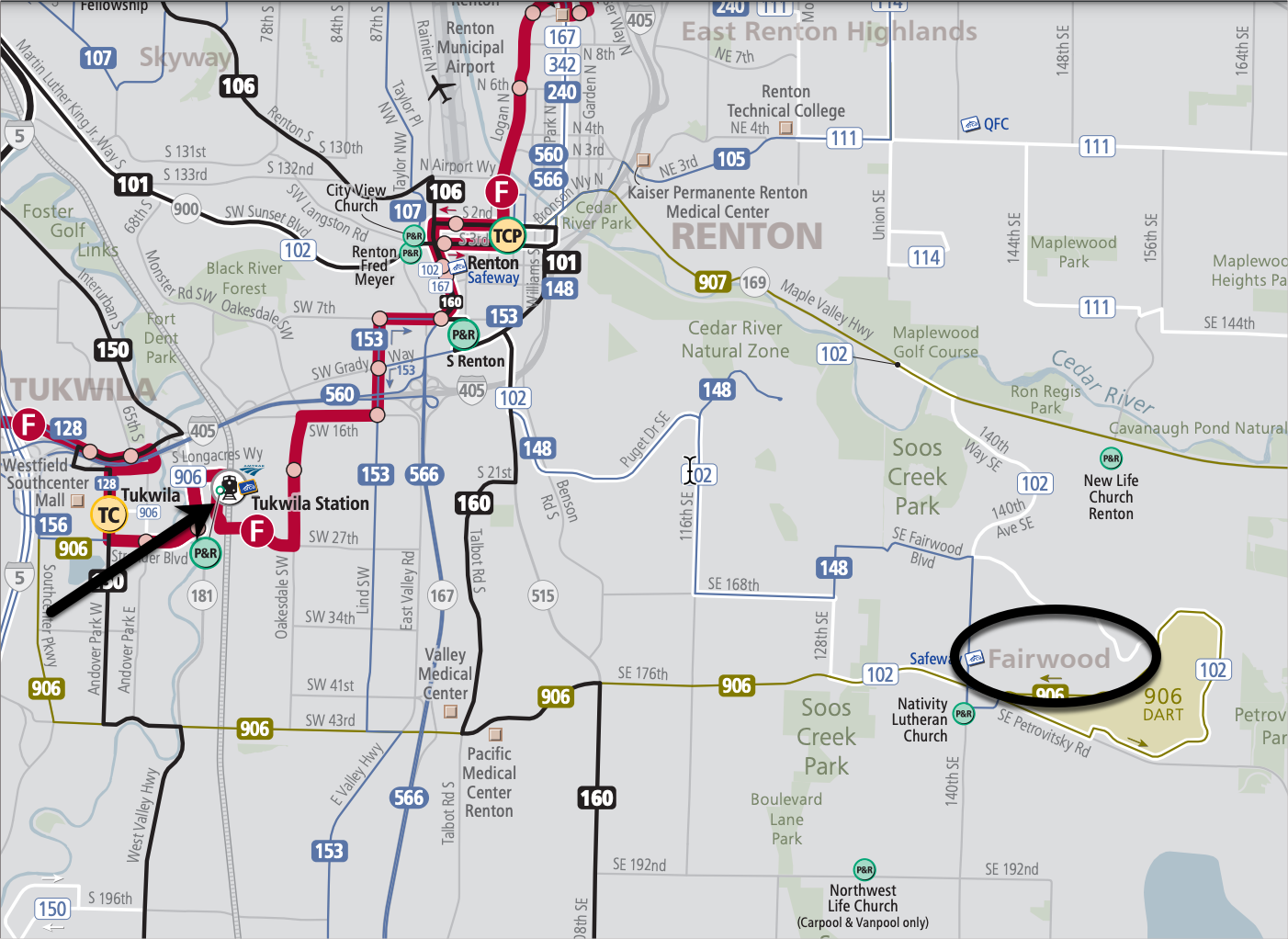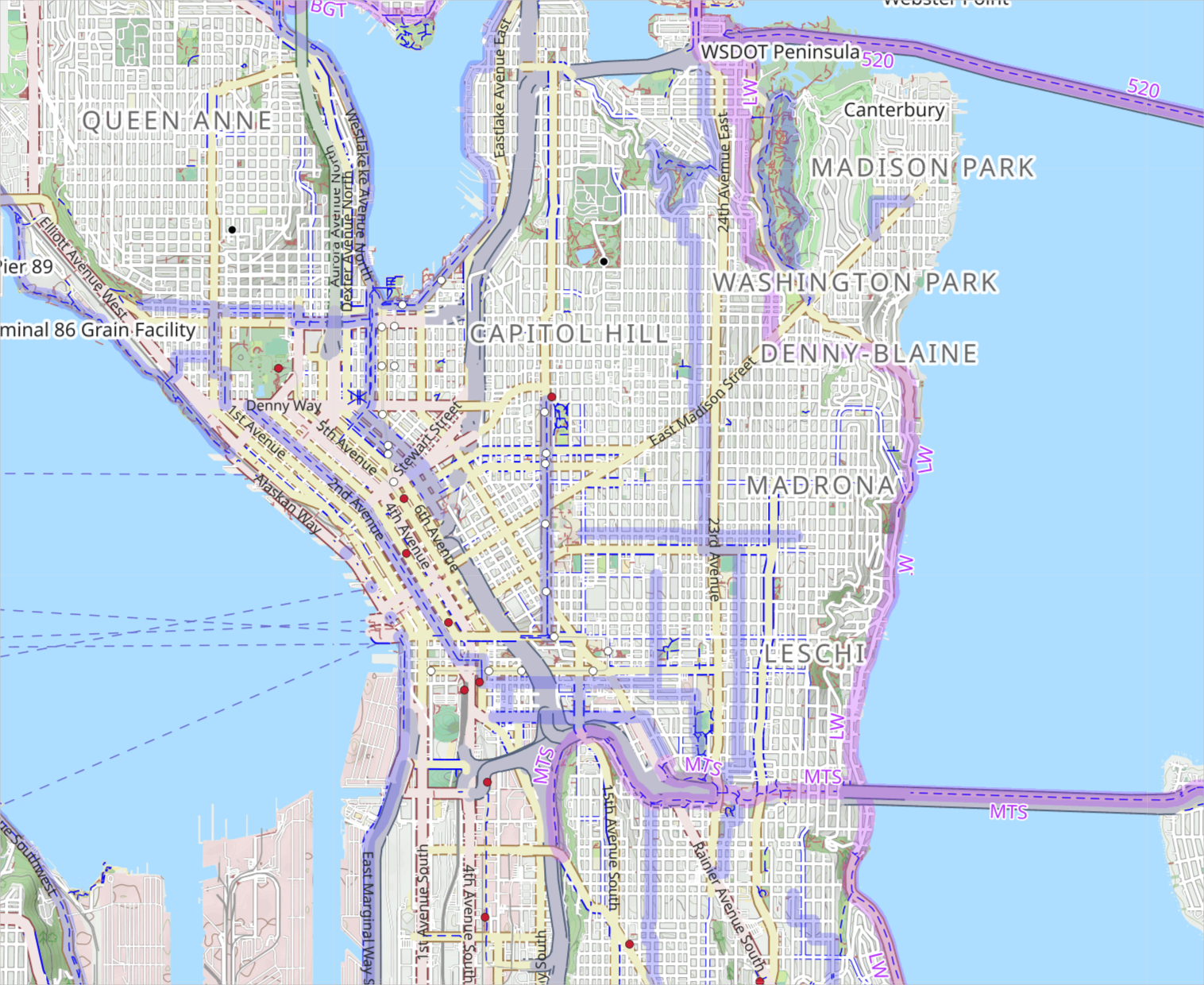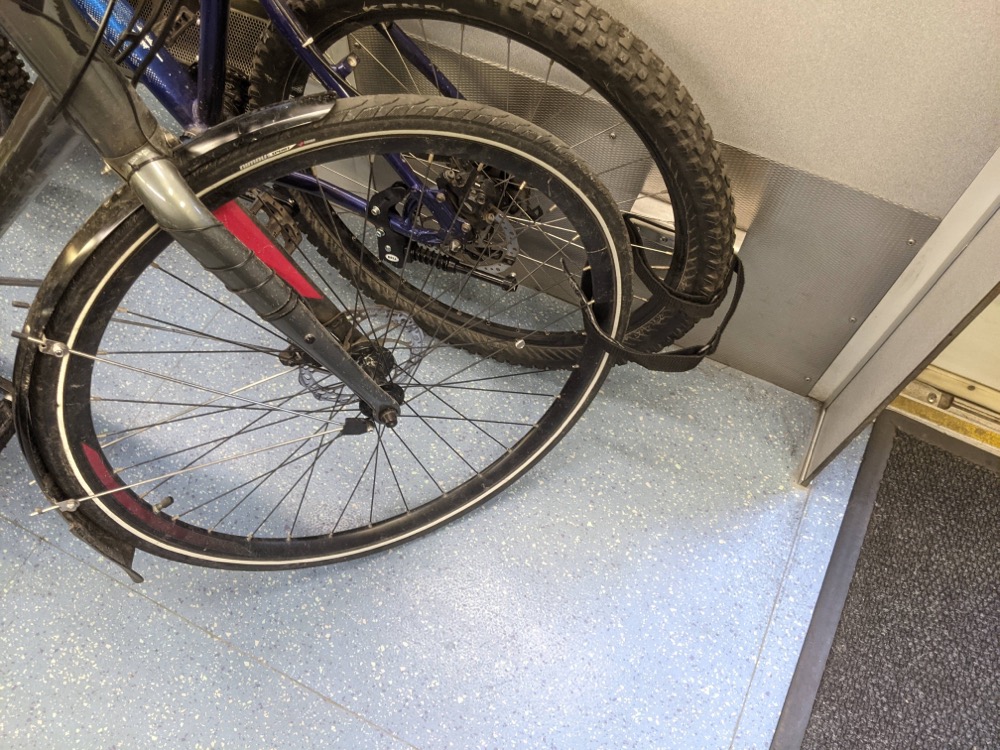Biking and public transportation in Renton and Seattle: Solving the first-mile and last-mile problems
- Bike commuting from Renton to Seattle
- Solving the first-mile problem
- Solving the last mile problem
- Conclusion: Car + Train + Bike
- Thoughts on public transportation
Bike commuting from Renton to Seattle
What’s the best way to get from Renton to downtown Seattle by bike? Renton is huge in terms of the square miles it covers; I live in Cascade-Fairwood, which is about a 30 minute drive to Seattle if there’s no traffic. If there is traffic, the drive is about 60 minutes on average. The distance is only 22 miles, which would be manageable along a dedicated bike path riding an ebike, but no such path exists.
There are good commuter lines running north/south — primarily with the Sounder, which is a train that runs on schedule, is clean, and rides smoothly. However, getting from my house to the Sounder station (the first-mile problem) and from the downtown station to my office building (the last-mile problem) are best solved by adding in a car and bike segment to the commute.
By the way, the terms first-mile and last mile are commonly used to describe these issues. See Last mile (transportation): Usage in transportation networks on Wikipedia for more details. The article explains that as housing costs rise and people are pushed out further into the suburbs, it gets harder for them to reach transportation networks. As a result, they become dependent on cars, which adds to the congestion problems in cities.
Solving the first-mile problem
I love the Sounder. But getting to the Sounder from my house involves going 6 miles west down roads that aren’t built with cyclists in mind. The shoulders on nearly every road are either nonexistent, fluctuate in width, or give you no more than 2-3 feet of room. Additionally, cars drive fast along these roads (going 45-50 mph), often veering into the shoulder (as they glance at their phones, I assume), and they don’t expect to see cyclists because cyclists are so rare in Renton. With the dark early morning and the frequent rain, the reduced visibility is a real safety threat to biking on these shoulders.
I have studied the map of my area for hours looking for safe east/west routes to the train. There are none that look safe.

I even tried riding on the sidewalk for portions of a route — it didn’t take long to realize that sidewalk cycling wasn’t going to work. Every interruption in the sidewalk (with an intersecting street) poses high risks because cars don’t see bikes on sidewalks, so every time you see a car at a cross street, you have to pretend you’re invisible, slowing way down and often going around their rear bumper.
Additionally, pedestrians (with earbuds in, so they can’t hear you) frequently walk on the sidewalks, especially students walking to school, so you have to go around them; dodging pedestrians might involve jumping off the curb into the street and then re-entering. Garbage bins, telephone poles, mailboxes, construction, cracks, and other random items make sidewalk riding a challenging obstacle course (it is actually legal in Seattle to ride on sidewalks, though). Running into a telephone pole might not be as traumatic as a car collision, but it could also be hospitalizing. Most experienced cyclists say that sidewalk riding is notably more dangerous than shoulder riding, even if the shoulder is marginal.
Experienced cyclists will recommend that you “take the road” in these situations (meaning, that you ride in the middle of the lane like a car). Or that you ride on the left edge of the shoulder, making you more noticeable. However, I find this approach unnerving for extended periods of time. Especially when drivers of big trucks can “roll coal” (output clouds of exhaust) and swerve into your lane and collide with you, and not even go to jail, it gives me pause. There doesn’t seem to be much punishment for drivers hitting cyclists. See A teenager allegedly hit 6 bicyclists with his truck, sending 3 to the hospital. A biker says the driver was harassing them. Or this one: Driver Who Hit Jets Assistant Coach Greg Knapp Won’t Be Charged Following His Death. These recent news stories makes me think that a careless driver could hit me, then say he or she didn’t see me, and there would be little or no punishment.
Although there’s no direct east/west route in Renton that provides a safe bike route, what about taking a bus from the nearest bus stop to a transit hub, and then taking another bus from the transit hub to the Sounder or even directly downtown? In short, what about taking two buses to get where I want to be?
The bus lines in the King County Metro are quite impressive. Take a look at this system map with its dizzying sprawl of bus lines and vehicle options.

I experimented with at least half a dozen bus routes and ways into the city during the past few weeks, often taking two buses to get to my destination. Unfortunately, I found that buses are problematic in several ways:
-
Their schedules aren’t reliable. It’s mostly an experience of waiting and wondering when the bus will come, if it perhaps already came, when the next will arrive, where it is, and so on. (This is no fault of King County Metro but inherent to driving on roads that have fluctuating traffic.)
-
Due to unreliable timing, buses don’t always make other transit connections. You might be waiting for a certain bus that will connect to a Sounder train, only to find that it arrives too late and you miss the connection.
-
The bus is bumpy and bouncy, making it hard to do much real work on it. In addition to wearing a mask and struggling to see through fogged glasses, the bumpy road jostles me around, makes it hard to type, and I sometimes get carsick.
-
Many of the bus stops are kind of dingy and dirty, especially in the urban centers. Sometimes people board who smell strongly of marijuana or cigar smoke. This can make the ride less pleasant.
If you set up a connection that involves two forms of public transportation (e.g., bus to train), you have to buffer in time for each connection. So even if the bus is a 20-minute ride and the train is a 20-minute ride, your wait time for each could be 10+ minutes (making it a 60-minute route). It’s uncertain enough just waiting for a single public transportation option, let alone two and hoping they will efficiently connect with each other.
To solve the first-mile problem, then, I believe a car of some sort is necessary. If there’s no safe bike path to get to a mass transit option, and the bus times are unreliable and time consuming, then a car can get you there quickly, especially if you’re leaving from a residential area. Fortunately, for me this car ride is only 15 minutes and doesn’t suffer from too much traffic congestion (nothing like the 405 to Bellevue or the I-5 to Seattle). I have a bike rack on my car to easily transport my bike.
Solving the last mile problem
Once I get to downtown Seattle (near King Street Station), I have to solve the “last mile” problem. Those 1-2 miles through downtown Seattle to the final destination (usually a company office) can take forever. If I have to walk to yet another bus stop and wait for another connection to take me across town, it could be another 30+ minutes.
Overall, riding multiple public transportation options to work can make the morning commute from Renton to Seattle around 2 hours, which cuts into the productivity of the day. Who wants to spend 4 hours commuting? This is no doubt why so many people prefer working from home or driving their own cars.
What’s the solution? It obviously depends where you live and what transit options exist, but in an ideal world, any viable commute option should involve only one public transportation leg — meaning, just the train, or just the bus. Not bus + train + bus again. This is where bicycles come into the picture and prove advantageous. Bicycles can solve the last-mile problem.
When I get to King Street Station (downtown Seattle), I can bike safely along 2nd Ave through a couple of city miles. Here’s my route:
This 2nd Ave route is a protected two-way bike path that feels amazingly safe (the only drawback is waiting at the many red lights at intersecting streets). The first block from King Street Station to the start of 2nd Ave requires you to walk or salmon up the sidewalk (on 2nd Ave Ext S), but after that it’s golden.
Here’s a short video showing the protected bike path along 2nd Ave, which is a fun ride and visually stimulating to see all the downtown liveliness:
From 2nd Ave, I cross over on Bell (which is closed to outside traffic because it’s a Seattle Stay Healthy Street). Bell winds around and into 9th, which has a single lane protected bike path.
Overall, if you find a good connecting street with a protected bike lane (even if it takes you out of your way), hopefully you can get fairly close to your destination in a safe way. Openstreetmap has a good high-level view of the cycle lanes in Seattle:

The first time I biked in downtown Seattle, I didn’t limit myself to streets with bike lanes, and it was terrifying. I rode in bus lanes and kept checking behind me for buses. (As a heads up, never bike along 3rd Avenue — this is almost like a freeway for buses going both ways.) Later I learned to plan more carefully and locate these safe routes.
Note that you could also use the bike-share or scooter-share (Lime, Wheels) in the city for these last mile segments. It’s interesting to see the bike/scooter shares that line the streets. Normally, I’d be all for these bikeshare options. However, these options cost an outrageous 39 cents a minute in Seattle, plus $1 to unlock. A 20-minute ride to my destination would be about $8. It seems much easier to bring your own bike or scooter.
If you do bring your bike on the Sounder, note that the velcro straps for securing two bikes per car are a poorly thought solution.

(Caltrain in the Bay area has a much better model for transporting bikes.)
Conclusion: Car + Train + Bike
Overall, I have come to the following conclusion about biking to work in my area. Getting from Renton to Seattle in an acceptable amount of time (~ one hour) requires three forms of transportation:
- Car (first-mile segment)
- Train (bulk of the journey)
- Bike (last-mile segment)
In short, drive car to a place where it’s safe to bike to the train. In my case, this might involve biking to a nearby park (e.g., Three Friends Fishing Hole park, or Russell Woods Park, or where the Green River trail intersects the Interurban trail at Foster Park) that connects to a protected bike path (Green River trail or Interurban trail) that runs into a train station (Tukwila Sounder Station or Kent Sounder Station). Something like this:
I could park as close or far away as I want to bike. For example, I could park directly at the Tukwila Sounder Station if I don’t want to bike at all (except once I get downtown). But I enjoy having a little window of exercise time, so for me that ideal length is about 7-8 miles miles total each way. Two north/south trails in Renton have great paths to major transit stations: the Green River trail (a beautiful meandering, flat ride), and the Interurban Trail South (which is a straight ride through a dystopian hinterland behind industrial warehouses — watch out for frenetic-running rabbits).
Then I take the Sounder into downtown Seattle at King Street Station, and bike the last leg through the city along 2nd Avenue, over to 9th Avenue, and up to South Lake Union.
(Although the car + train + bike option is the best, it doesn’t solve all my problems. Some mornings I drive in to play early morning basketball (leaving my house at 5:45 am.), and on those days I admittedly drive in by car only because traffic is light at that time, and I don’t want to leave any earlier than that because I need sleep. I’m still working out my plan for public transport on those days.)
Thoughts on public transportation
While thinking about biking routes, I also had some realizations about public transportation and why it’s problematic. Why don’t more people use public transportation? There’s a principle called Mooer’s Law (not the more familiar Moore’s Law) that states that “An information retrieval system will tend not to be used whenever it is more painful and troublesome for a customer to have information than for him not to have it.” Adapting this principle to the public transportation scenario, people only change habits when the pain of not changing the habit is worse than changing the habit.
If the pain of driving all the way into work exceeds the pain of taking public transportation, then more people will take public transportation. Right now, it’s usually more comfortable to drive into work, even in slow, congested traffic. It still only takes an hour by car, whereas the public transportation option will usually take at least an hour and a half (not taking into account any time recovered on the train where you can actually work).
If cities want to solve traffic congestion and encourage more people to take the bus/train/bike, etc., the solution is simple: make it less convenient to drive. Block off more streets as closed streets (like what Seattle is doing with it’s Stay Healthy Streets). People won’t bike on the streets if they don’t feel safe — even experienced cyclists. Start closing down more streets and making congestion more problematic for cars, and people will gravitate more towards the public transportation options. This graphic is really telling:
Those damn bike lanes
While the artist seems to be depicting the disproportionate space cars take up, there’s another message here: it’s far too comfortable to drive. If we make it a nightmare to drive a car in the city, people will choose other options.
I would also like to see more greenways / closed roads not just in Seattle but elsewhere, specifically in Renton. For example, take just one east/west road from Renton to a Sounder station and close it off to cars, making it available to bikes/pedestrians only. Then in the city, add many more of these Stay Healthy Streets. However, congestion in residential roads isn’t as much of a problem, and you need a car in the suburbs anyway, so I imagine this won’t happen. (BTW, there’s a great subreddit called /fuckcars that’s worth following.)
That’s it for my thoughts on bike commuting from Renton to Seattle. Another challenge related to cycling in Seattle is the rain. I have more thoughts related to riding in the rain, but I’ll save that for another post.
About Tom Johnson

I'm an API technical writer based in the Seattle area. On this blog, I write about topics related to technical writing and communication — such as software documentation, API documentation, AI, information architecture, content strategy, writing processes, plain language, tech comm careers, and more. Check out my API documentation course if you're looking for more info about documenting APIs. Or see my posts on AI and AI course section for more on the latest in AI and tech comm.
If you're a technical writer and want to keep on top of the latest trends in the tech comm, be sure to subscribe to email updates below. You can also learn more about me or contact me. Finally, note that the opinions I express on my blog are my own points of view, not that of my employer.
